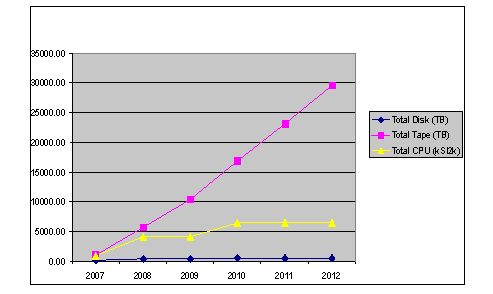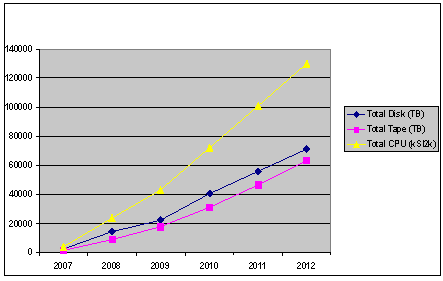   |  |
Computing Technical Design Report
Clearly, the system described by Table 7-1 will not be constructed in its entirety by the start of data taking in 2007/2008. From a cost point of view, the best way to purchase the required resources would be `just in time'. However, the early period of data taking will doubtless require much more reprocessing and less compact data representations than in the mature steady state. There is therefore a requirement for early installation of both CPU and disk capacity.

|

|

|

|
It is therefore proposed that by the end of 2006 a capacity sufficient to handle the data from first running under the conditions described in Section 2.2 , needs to be in place, with a similar ramping up of the Tier-1 facilities. During 2007, an additional capacity required for 2008 should be bought. In 2008 an additional full-year of capacity should be bought, including the additional archive storage medium/tape required to cope with the growing dataset. This would lead to a capacity, installed by the start of 2008, capable of storing the 2007 and 2008 data as shown in Table 7-2; the table assumes that only 20% of the data rate is fully simulated.
For the Tier-2s, a slightly later growth in capacity, following the integrated luminosity, is conceivable provided that the resource-hungry learning-phase is mainly consuming resources in Tiers 0 and 1. However, algorithmic improvements and calibration activity will require also considerable resources early in the project. As a consequence, we have assumed the same ramp-up for the Tier-2s as for the higher Tiers.
Once the initial system is built, there will for several years be a linear growth in the CPU required for processing, as the initial datasets will require reprocessing as algorithms and calibration techniques improve. In later years, subsets of useful data may be identified to be retained/reprocessed, and some data may be rendered obsolete. However, for the near future, the assumption of linear growth is reasonable. For storage, the situation is more complex. The requirement exceeds a linear growth if old processing versions are not to be overwritten. On the other hand, as the experiment matures, increases in compression and selectivity over the stored data may reduce the storage requirements.
The project growth in the required resources in the various Tiers are shown in See The projected growth in ATLAS Tier-0 resources with time.-See The projected growth of the combined ATLAS Tier-2 facilities.. The projections do not include the replacement of resources, as this depends crucially on the history of the sites at the start of the project.
   |  |
Copyright © CERN 2005